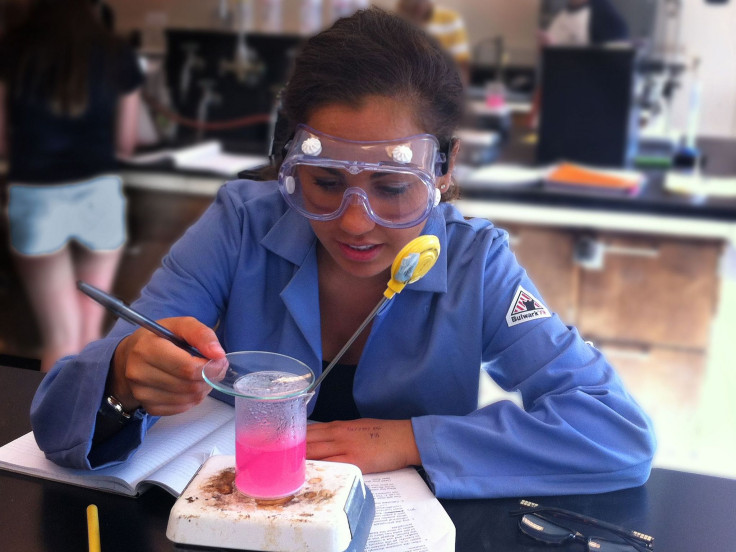Women In Science: Poor Self-Perceived Ability In Math Leads To Less Female Scientists, STEM Subjects

As the rate of women enrolled in STEM (science, technology, engineering and math) subjects is still fairly low relative to their male counterparts, researchers are wondering what it is about the realm of math and science that is keeping women away. They know it is not that women are incapable; in fact, women have proved themselves capable time and time again, especially in the UK, where women taking two-year vocational courses in science and mathematics are outpacing their fellow male students. Yet today, women only hold 27 percent of all computer science jobs, while only 20 percent of women graduate with a related computer science degree. Researchers from Florida State University who have sought to study just that, believe it all boils down to a matter of perceptions.
According to their new study published in the journal of Frontiers in Psychology, there is a pervasive misconception that starts when American girls are in high school, and prevents them from continuing on to physics, engineering, mathematics, or computer science (PEMC) careers later on. This belief comes from the misunderstanding that “difficult” mathematics is something you either can or cannot do, and that there is no room to learn. Researchers hope that now that they have isolated this way of thinking, they can change it with more positive enforcement for girls coming from school, home, and government policy.
“Our results indicate the potential for more women to move into PEMC if they perceive their mathematics ability as strong, and open to growth,” said Lara Perez-Felkner, assistant professor of higher education and sociology at Florida State in a recent press release.
Perez-Felkner worked with doctoral students Samantha Nix and Kirby Thomas to see how perceptions of gender potentially affect perceptions of ability, which may ultimately skew college major choices. Compiling records from the Educational Longitudinal Study of the U.S. National Center for Education Statistics, researchers were able to analyze 4,450 students from 750 high schools across the United States between the years 2002 to 2012.
The results revealed what researchers had previously believed: it is all a matter of mindset. Self-perceived mathematics ability highly dictated whether or not women pursued math in the future. Researchers found that high school boys tended to overrate their mathematical abilities, while girls tended to underrate them; however, 12th grade girls who told researchers they could successfully complete the most challenging mathematical problems were 3.3 times more likely to choose a PEMC major for college. This proved to be the case across the board, regardless of science courses taken, ethnicity, college entrance exam scores, or college selection.
Researchers found that the “growth mindset,” or believing that mathematical ability can be fostered through learning, added to the amount of girls entering into PEMC subjects. Girls who displayed the “growth mindset” were 2.3 times more likely to pursue a PEMC major than those who reported the opposite belief.
Overall, researchers discovered that girls were 3.7 times less likely to pursue a PEMC major than boys, but were 3.8 times more likely to pursue a major in health science than the boys. When both girls and boys completed both high school courses physics 1 and chemistry 1, they were 1.9 times more likely to major in a PEMC subject than the entire body of their peers. This increased to 2.5 times more likely for both boys and girls if they also completed physics 2 and chemistry 2.
“By focusing on students’ perceived ability under challenge, we are getting closer to the ‘real’ world context, where mathematics anxiety may operate,” said doctoral student Samantha Nix. “Most people believe they can do some mathematics, such as splitting a dinner bill with friends, but fewer believe they can do mathematics they perceive as ‘difficult.’ Here we show that this belief can influence the decision to specialize in mathematics-intensive fields, for both women and men.”
The key to changing the gender gap, researchers believe, is to shift widespread perceptions over to the “growth mindset.” If this is done, the chances that women will enter a mathematical field will increase, and women’s underrepresentation in PEMC fields, as reported by the OECD and the U.S. National Science Foundation, will be a thing of the past. As of right now, researchers note, this gender gap is not advantageous to anyone; by sequestering women to other fields, both science and society lose out on potential innovation, while women also miss out on higher-than-average income jobs. Research also shows that women who learn to code often feel empowered by their jobs, and that is something that can benefit everyone.
“It is important for the U.S. and other nations to continue to invest in interventions to end gender segregation in PEMC science,” Perez-Felkner said. “For instance, students may need to hear that encountering difficulty during classwork is expected and normal, and does not say anything about ability to become a successful scientist. In addition, instructors may want to ask themselves if they are giving the same feedback to young women and men who deal successfully with a difficult mathematics problem in class.”
With this shift in attitude, we can expect to welcome a lot more women into the world of science and mathematics than ever before. Needless to say, if this change would have been made when I was in high school, I might have reconsidered the path I decided to take.
Sources: Nix S, Perez-Felkner L, Thomas K. Perceived mathematical ability under challenge: a longitudinal perspective on sex segregation among STEM degree fields. Frontiers in Psychology. 2015.



























